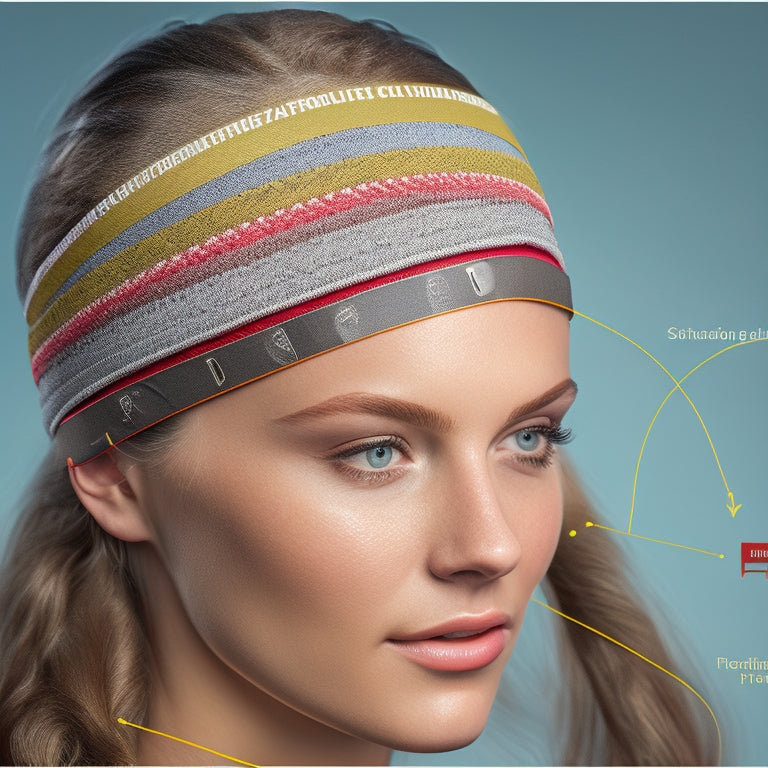
How Do You Stabilize a Headband?
Share
You stabilize a headband by getting the right size, adjusting the Velcro strap for comfort and perfect tension, and adding grip with silicone strips. Use headband clips or slides for extra stability, and wear a thin headband liner for added security. For extra grip, try applying hairspray or using double-sided tape. You can also add a headband stabilizer or opt for a sweat-resistant headband for intense workouts. With these tips, you'll be on your way to a secure, slipping-free fit. Now, take it to the next level by exploring more expert tips and tricks to take your headband game to new heights!
Key Takeaways
• Use accurate head measurements and manufacturer sizing charts to ensure a proper fit and adjust Velcro straps for optimal tension.
• Add stability accessories like headband clips, silicone strips, or a thin liner for sweat absorption to enhance grip and comfort.
• Apply grip enhancers like hairspray, double-sided tape, or adhesive materials strategically to secure the headband in place.
• Utilize tape application techniques that focus on key areas like temple tips and ear folds, ensuring strong adhesion and sweat resistance.
• Customize your stabilization solution with attachable velcro or snaps, breathable materials, and adjustable profiles for a snug, comfortable, and secure fit.
Choose the Right Headband Size
Snag a headband that fits like a glove by measuring your head's circumference, guaranteeing a snug and comfortable wear.
To do this, you'll need to determine your head size using a flexible tape measure or a string. Wrap the tape measure or string around the widest part of your head, just above your eyebrows and ears. Hold the tape measure or string level and make sure it's not too tight or too loose.
Take note of the measurement in inches or centimeters and refer to a sizing chart to find your corresponding headband size. Measuring methods like this guarantee you get the perfect fit.
Consult sizing charts provided by the manufacturer or retailer to guarantee you're getting the right size for your head.
Adjust the Velcro Strap
With your perfectly sized headband in place, it's time to fine-tune the fit by adjusting the Velcro strap to your comfort level.
You want to achieve the perfect balance of Velcro tension – not too tight, not too loose. To do this, simply pull the strap to your desired length and press the Velcro firmly to secure it.
Make sure the strap flexibility allows for a smooth adjustment, so you can move freely without restrictions.
As you adjust, pay attention to how the headband sits on your head. You should feel secure, yet unrestricted.
Use Headband Clips or Slides
You're almost there! To take your headband game to the next level, you'll want to secure the headband in place using clips or slides.
Secure the Headband
Secure your headband in place by fastening the clips or slides, ensuring a snug and comfortable fit that won't slip or slide during wear. This is especially important if you're using sweat-resistant materials that can get slippery when you're active. By securing your headband, you'll enjoy uninterrupted freedom to move as you please.
Here are four benefits of securing your headband:
-
Unbeatable Stability: Say goodbye to constant adjustments and hello to a worry-free experience.
-
Sweat-Proof Performance: Enjoy your favorite activities without worrying about your headband sliding off.
-
Comfort Redefined: Get the perfect fit with headband anchors that keep your band in place.
- Unbridled Freedom: Move, run, jump, or dance – your headband will stay put, giving you the freedom to live life to the fullest!
Adjust the Clips
Adjust the clips or slides to customize the fit, ensuring your headband hugs your forehead comfortably, and stays put even during high-intensity activities.
You'll want to experiment with different clip designs to find the one that works best for your hair type. If you have fine or thin hair, look for clips with a gentle grip to prevent slipping. Thicker or curlier hair? Opt for clips with a stronger hold.
Adjust the clips to sit snugly on your forehead, avoiding any pressure points or discomfort.
Position the Slides
Position the slides or clips at the ideal points on your forehead, about an inch apart, to guarantee a snug and even fit that won't slip or shift during exercise. This is essential for peak performance and comfort.
Here are some key considerations for slide adjustments:
-
Band Angles: Experiment with different angles to find the perfect fit for your forehead shape.
-
Slide Tension: Adjust the slides to achieve a comfortable grip without feeling too tight.
-
Forehead Contour: Ensure the slides follow the natural curve of your forehead for maximum stability.
- Mirror Check: Double-check your reflection to make sure the headband is perfectly positioned and symmetrical.
Add Grip With Silicone Strips
Now it's time to get a grip - literally! You'll want to strategically place silicone strips on your headband to maximize stability, and we'll explore the best placement options.
From there, you can experiment with different grip enhancement methods and strip sizes to find the perfect combo that keeps your headband in place.
Silicone Strip Placement
By strategically placing silicone strips along the inner band, you'll create a non-slip grip that keeps your headband firmly in place. This is especially important if you have a larger head size or plan to wear your headband during high-intensity activities.
To get the most out of your silicone strips, make sure to:
- Choose high-quality silicone with excellent adhesive strength to guarantee a secure grip.
- Opt for strips with a textured surface for added traction.
- Place strips at regular intervals to distribute the grip evenly.
- Experiment with different strip sizes and placements to find the perfect fit for your headband.
Grip Enhancement Methods
You can take your headband's grip to the next level by exploring additional grip enhancement methods, which can be used alone or in combination with silicone strips for an unbeatable hold.
One way to boost grip is by incorporating specialized grip materials, such as rubber or textured fabrics, into your headband's design.
You can also experiment with unique fabric weaving patterns to create a more secure fit. For example, a herringbone or chevron pattern can provide added traction, keeping your headband in place even during high-intensity activities.
Strip Size Options
Silicone strips come in a variety of sizes to cater to different head shapes and preferences, allowing you to customize the grip of your headband for a snug, secure fit. Whether you have a small, medium, or large head, there's a strip size that's just right for you.
With multiple material options to choose from, you can experiment with different textures and thicknesses to find the perfect combination. Here are some benefits you can expect from customizable strip sizes:
- Improved fit: Say goodbye to slipping and sliding with strips that conform to your unique head shape.
- Enhanced comfort: Breathe easy with strips that don't dig or chafe, even during intense activities.
- Increased confidence: Wear your headband with pride, knowing it's securely in place.
- Unlimited possibilities: Experiment with different strip sizes and materials to create the perfect fit for your active lifestyle.
Wear a Thin Headband Liner
Slipping on a thin headband liner underneath your favorite headband can guarantee a world of difference in keeping it stable. You'll be amazed at how this simple trick can maintain your headband in place, even during intense workouts or sweaty activities.
When choosing a liner, focus on fabric selection - look for breathable, moisture-wicking materials that'll aid with sweat absorption. This secures your headband stays dry and comfortable, allowing you to focus on your activity without distractions.
Secure With Bobby Pins
With a few strategically placed bobby pins, your headband will stay firmly in place, allowing you to tackle even the most vigorous activities with confidence.
Whether you have fine, curly, or thick hair, bobby pins can be a game-changer in keeping your headband secure. Here are some pin techniques to try:
-
Tuck and pin: Tuck stray hairs under your headband and secure with a bobby pin.
-
Section and pin: Divide your hair into sections and pin each one individually for maximum hold.
-
Pin at the roots: Secure your headband at the roots of your hair for added stability.
- Pin at the nape: Pin your headband at the nape of your neck for a sleek, polished look.
Apply Hairspray for Grip
As you finish styling your hair, a light hold hairspray can create an invisible grip, helping your headband stay put all day. This trick works wonders for most hair types, from fine to thick locks.
To get the most out of this technique, focus on the areas where your headband sits, such as your forehead, temples, and hairline. Hold the can 6-8 inches away and use a light, sweeping motion to distribute the spray evenly.
Don't overdo it, as too much product can leave a sticky residue. With the right spray technique, you'll enjoy a secure and comfortable fit that lets you move freely, without worrying about your headband slipping out of place.
Use Double-Sided Tape
When you're using double-sided tape to stabilize your headband, you'll want to strategically place it for maximum grip.
You'll need to secure the headband in a way that distributes the tape's adhesive power evenly, so it doesn't slip or slide around.
Tape Placement Matters
You'll get the most out of your double-sided tape by applying it strategically to the underside of your headband, focusing on areas where the fabric tends to shift or slip the most. This guarantees the adhesive strength of the tape is maximized, keeping your headband securely in place.
When placing the tape, consider the following key areas:
-
Temple tips: Where the headband meets your temples, ensuring a snug fit.
-
Forehead curve: Along the curved section that rests on your forehead.
-
Ear folds: Where the headband wraps around your ears, preventing slippage.
- Nape of the neck: At the back of the headband, securing it to your neck.
Secure the Headband
With your tape strategically placed, it's time to secure your headband by applying gentle pressure to the adhesive strips, making sure they're firmly attached to your skin. This will create a strong bond, ensuring your headband stays put.
As you press the tape, imagine the adhesive strips transforming into headband anchors, keeping your gear snug and secure.
To maintain the perfect fit, adjust the band tensioning by gently tugging on the ends. This will distribute the pressure evenly, providing a comfortable and stable fit.
With your headband now securely in place, you're free to move, sweat, and take on the day with confidence!
Strong Adhesive Needed
Double-sided tape proves to be a lifesaver when it comes to keeping your headband in place. Its strong adhesive properties form an unshakeable bond between the band and your skin. This bonding agent is the secret to a secure fit that lasts all day. You'll forget you're even wearing it!
Here are some benefits of using double-sided tape:
-
Industrial strength: Strong adhesives like industrial glues guarantee your headband stays put.
-
Sweat-resistant: Your headband won't budge even during intense workouts.
-
Skin-friendly: Gentle on your skin, so you can focus on your activity.
- Easy removal: No residue left behind, making it easy to take off.
With double-sided tape, you can enjoy freedom of movement without worrying about your headband slipping.
Add a Headband Stabilizer
Secure a small patch of velcro or a snap to the underside of your headband, positioned exactly where the stabilizer will sit. This will create a snug fit and prevent the stabilizer from shifting around.
Now, choose your stabilizer materials wisely – silicone, foam, or even 3D-printed plastic can work wonders. Consider stabilizer designs that fit your active lifestyle, like sleek and slim profiles or adjustable straps for a customizable fit.
For added freedom, opt for breathable materials that won't weigh you down.
With your stabilizer in place, you'll be ready to take on any adventure that comes your way – from marathons to yoga sessions, your headband will stay put!
Try a Sweat-Resistant Headband
You'll be drenched in sweat during intense workouts, so why not opt for a sweat-resistant headband that'll keep up with your active lifestyle? With moisture management and sweat absorption in mind, you'll want a headband that can keep up with your most intense exercises. Here are some benefits of a sweat-resistant headband:
-
Stays dry: No more soggy, heavy headbands weighing you down.
-
Comfortable: Breathable materials keep you cool and comfortable.
-
Secure fit: No slipping or sliding, even during the toughest workouts.
- Long-lasting: Quality materials make sure your headband stays in top shape.
With a sweat-resistant headband, you'll be free to focus on your workout, not on adjusting your headgear. Say goodbye to distractions and hello to a more intense, more effective workout!
Frequently Asked Questions
Can I Wear a Headband With a Sensitive Scalp or Skin Allergies?
If you're worried about rocking a headband with sensitive skin or allergies, don't stress! Take a patch test, do an allergy test, and opt for hypoallergenic materials to avoid any skin reactions, and you're good to go!
How Do I Prevent Headbands From Slipping on Sweaty Hair?
When you're rocking sweaty hair, you need a headband that keeps up! Look for sweat-absorbing materials and adjustable straps to secure your style, no matter your hair texture, so you can slay the day without slipping up!
Can I Use Hairspray on Any Type of Hair or Headband Material?
You're ready to lock in your style! For a secure hold, you can use light-hold or extra-hold hairspray on most hair types, but beware: it might not be suitable for delicate or damaged locks.
Are Headband Stabilizers Suitable for All Headband Types and Sizes?
When selecting headband stabilizers, you'll find they're not one-size-fits-all; consider customization options and material limitations to guarantee a secure fit, as some stabilizers might not work with certain headband types or sizes.
Can I Use a Headband With Hair Extensions or Braids?
"Like a goddess, you weave your hair into a majestic crown, but can you rock a headband with hair extensions or braids? Yes, with the right hair extension methods and braid anchor techniques, you can stabilize your headband and slay the game!"
Related Posts
-

3 Essential Marketing Tips for Dance Makeup Artists
To shine online and attract new clients, you'll need a solid marketing strategy. First, boost your online visibility ...
-

Best Ballet Dancer Accessories for Peak Performance
To open up your peak performance as a ballet dancer, invest in vital accessories. Start with well-fitted footwear—cho...
-

Essential Spandex Shorts for Yoga and Pilates
Essential spandex shorts are vital for your yoga and Pilates practice. Look for moisture-wicking technology to keep y...


